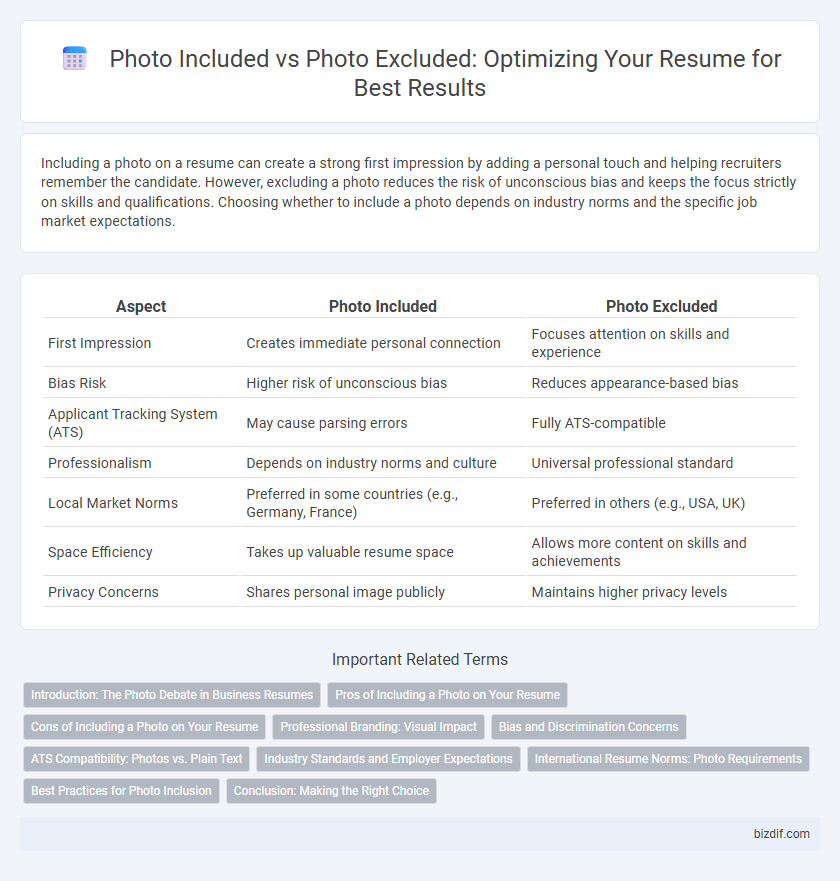Including a photo on a resume can create a strong first impression by adding a personal touch and helping recruiters remember the candidate. However, excluding a photo reduces the risk of unconscious bias and keeps the focus strictly on skills and qualifications. Choosing whether to include a photo depends on industry norms and the specific job market expectations.
Table of Comparison
| Aspect | Photo Included | Photo Excluded |
|---|---|---|
| First Impression | Creates immediate personal connection | Focuses attention on skills and experience |
| Bias Risk | Higher risk of unconscious bias | Reduces appearance-based bias |
| Applicant Tracking System (ATS) | May cause parsing errors | Fully ATS-compatible |
| Professionalism | Depends on industry norms and culture | Universal professional standard |
| Local Market Norms | Preferred in some countries (e.g., Germany, France) | Preferred in others (e.g., USA, UK) |
| Space Efficiency | Takes up valuable resume space | Allows more content on skills and achievements |
| Privacy Concerns | Shares personal image publicly | Maintains higher privacy levels |
Introduction: The Photo Debate in Business Resumes
Including a photo on a business resume can create a memorable first impression and personalize the application but may also lead to unconscious bias during the initial screening. Excluding a photo aligns with non-discrimination practices and maintains focus on qualifications, skills, and experience, which are critical for recruiters and applicant tracking systems. The photo debate in business resumes hinges on industry norms and regional practices, requiring candidates to tailor their approach based on the target job market.
Pros of Including a Photo on Your Resume
Including a professional photo on your resume can create a strong initial impression and help personalize your application, making it easier for recruiters to remember you. It enhances your brand identity and can convey confidence, professionalism, and approachability. Studies suggest that resumes with photos receive more callbacks, particularly in industries like marketing, sales, and customer service where personal presentation is valued.
Cons of Including a Photo on Your Resume
Including a photo on your resume can lead to unconscious bias, affecting hiring decisions based on appearance rather than qualifications. It may also violate anti-discrimination laws in certain regions, risking your application being disregarded or removed. Recruiters often prioritize skills and experience, making photos irrelevant and potentially distracting from the content of your resume.
Professional Branding: Visual Impact
Including a professional photo on a resume enhances personal branding by creating a strong visual impact that helps recruiters remember candidates more easily. High-quality images convey professionalism and approachability, reinforcing a candidate's identity and making resumes stand out in competitive job markets. However, in industries emphasizing skills over appearance or in regions where photo inclusion may lead to bias, excluding photos ensures focus remains on qualifications and experience.
Bias and Discrimination Concerns
Including a photo on a resume can inadvertently trigger unconscious bias and lead to discrimination based on race, gender, age, or appearance, potentially impacting fair hiring decisions. Studies indicate that resumes without photos receive more equitable evaluations, promoting merit-based assessments free from prejudice. Many organizations now encourage photo exclusion to foster diversity and inclusion in recruitment processes.
ATS Compatibility: Photos vs. Plain Text
Including a photo on a resume can hinder ATS compatibility because most Applicant Tracking Systems are designed to parse plain text and often fail to accurately read or interpret images. Resumes without photos ensure that all relevant information is extracted and analyzed correctly, improving the chances of passing the initial automated screening. Emphasizing plain text over images enhances ATS readability and prevents potential bias during the recruitment process.
Industry Standards and Employer Expectations
Including a photo on a resume varies by industry and region, with creative fields like marketing and design often favoring visuals to showcase personality, while finance and law sectors typically exclude photos to prioritize professionalism and reduce bias. Employer expectations generally align with industry standards, emphasizing skills and experience over appearance, especially in countries like the US and UK where photo inclusion is uncommon. Understanding these nuances helps tailor resumes to meet recruiter preferences and improve hiring outcomes.
International Resume Norms: Photo Requirements
Including a photo on an international resume depends heavily on regional preferences and industry norms; most North American and UK employers prefer resumes without photos to avoid unconscious bias. In contrast, many European and Asian countries often expect a professional headshot as part of the application to establish personal identity. Understanding these variations in photo requirements is crucial for job seekers targeting global markets to ensure their resumes meet local expectations and improve interview prospects.
Best Practices for Photo Inclusion
Including a professional photo on a resume can enhance personal branding and create a memorable first impression, especially in industries like marketing, sales, or creative fields. High-quality, well-lit photos featuring appropriate attire aligned with the job role increase recruiter engagement and help convey professionalism and approachability. Avoid casual or overly stylized images, ensuring the photo complements the resume without overshadowing content or introducing bias.
Conclusion: Making the Right Choice
Including a photo on a resume can personalize your application and create a memorable first impression, especially in creative industries or regions where it is standard practice. Excluding a photo helps prevent unconscious bias and keeps the focus solely on skills, experience, and qualifications, which is preferred in many professional and international settings. The right choice depends on industry norms, geographic location, and the specific role, balancing professionalism with personalization to maximize your resume's impact.
Photo included vs Photo excluded Infographic

 bizdif.com
bizdif.com